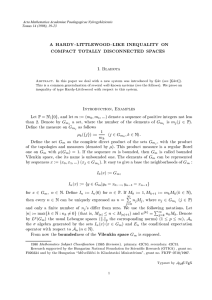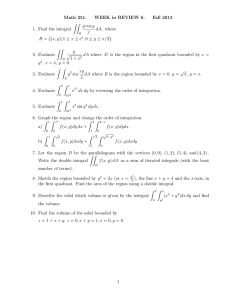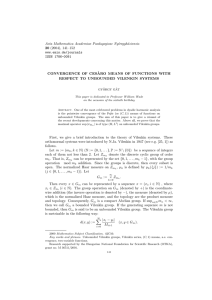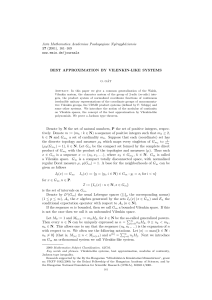TWO-DIMENSIONAL SUNOUCHI OPERATOR WITH RESPECT TO VILENKIN-LIKE SYSTEMS Communicated by S.S. Dragomir
advertisement
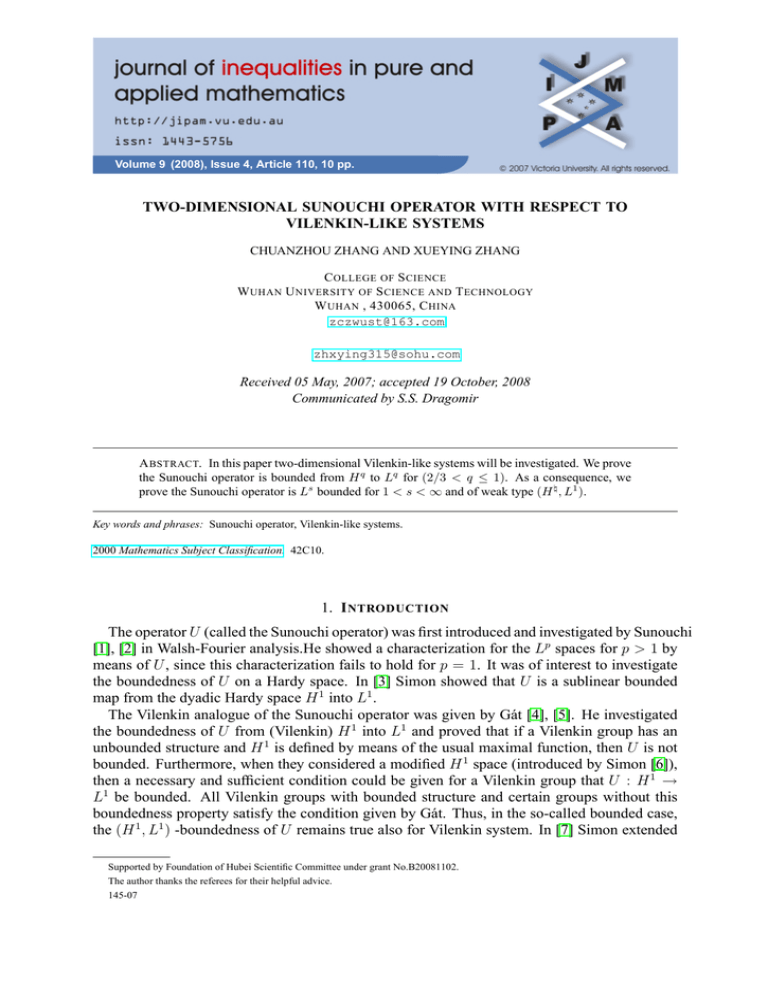
Volume 9 (2008), Issue 4, Article 110, 10 pp.
TWO-DIMENSIONAL SUNOUCHI OPERATOR WITH RESPECT TO
VILENKIN-LIKE SYSTEMS
CHUANZHOU ZHANG AND XUEYING ZHANG
C OLLEGE OF S CIENCE
W UHAN U NIVERSITY OF S CIENCE AND T ECHNOLOGY
W UHAN , 430065, C HINA
zczwust@163.com
zhxying315@sohu.com
Received 05 May, 2007; accepted 19 October, 2008
Communicated by S.S. Dragomir
A BSTRACT. In this paper two-dimensional Vilenkin-like systems will be investigated. We prove
the Sunouchi operator is bounded from H q to Lq for (2/3 < q ≤ 1). As a consequence, we
prove the Sunouchi operator is Ls bounded for 1 < s < ∞ and of weak type (H \ , L1 ).
Key words and phrases: Sunouchi operator, Vilenkin-like systems.
2000 Mathematics Subject Classification. 42C10.
1. I NTRODUCTION
The operator U (called the Sunouchi operator) was first introduced and investigated by Sunouchi
[1], [2] in Walsh-Fourier analysis.He showed a characterization for the Lp spaces for p > 1 by
means of U , since this characterization fails to hold for p = 1. It was of interest to investigate
the boundedness of U on a Hardy space. In [3] Simon showed that U is a sublinear bounded
map from the dyadic Hardy space H 1 into L1 .
The Vilenkin analogue of the Sunouchi operator was given by Gát [4], [5]. He investigated
the boundedness of U from (Vilenkin) H 1 into L1 and proved that if a Vilenkin group has an
unbounded structure and H 1 is defined by means of the usual maximal function, then U is not
bounded. Furthermore, when they considered a modified H 1 space (introduced by Simon [6]),
then a necessary and sufficient condition could be given for a Vilenkin group that U : H 1 →
L1 be bounded. All Vilenkin groups with bounded structure and certain groups without this
boundedness property satisfy the condition given by Gát. Thus, in the so-called bounded case,
the (H 1 , L1 ) -boundedness of U remains true also for Vilenkin system. In [7] Simon extended
Supported by Foundation of Hubei Scientific Committee under grant No.B20081102.
The author thanks the referees for their helpful advice.
145-07
2
C HUANZHOU Z HANG AND X UEYING Z HANG
this result, by showing the (H q , Lq )-boundedness of U for all 0 < q ≤ 1. Moreover, the
equivalence
1
kf kH q ∼ kU f kq
<q≤1
2
was also obtained for f with mean value zero.
In this paper we consider a two-dimensional case with respect to generalized Vilenkin-like
systems.
2. P RELIMINARIES AND N OTATIONS
In this section, we introduce important definitions and notations. Furthermore, we formulate
some known results with respect to Vilenkin-like systems, which play a basic role in further
investigations. For details, see [8] by Vilenkin and [9] by Schipp, Wade, Simon and Pál.
Let m := (mk , k ∈ N) (N := {0, 1, . . . , }) be a sequence of integers, each of them not less
than 2. Denote by Zmk the mk -th cyclic group (k ∈ N). That is, Zmk can be represented by
the set {0, 1, . . . , mk − 1}, where the group operator is the mod mk addition and every subset
is open. The Harr measure on Zmk is given such that µ({j}) = m1k (j ∈ Zmk , k ∈ N).
Let Gm denote the complete direct product of Zmk ’s equipped with product topology and
product measure µ, then Gm forms a compact Abelian group with Haar measure 1. The elements
of Gm are sequences of the form (x0 , x1 , . . . , xk , . . . ), where xk ∈ Zmk for every k ∈ N and the
topology of the group Gm is completely determined by the sets
In (0) := {(x0 , x1 , . . . , xk , . . . ) ∈ Gm : xk = 0 (k = 0, . . . , n − 1)}
(I0 (0) := Gm ). Let In (x) := In (0) + x (n ∈ N); M0 := 1 and Mk+1 := mk Mk for k ∈
N,
P∞the so-called generalized powers. Then every n ∈ N can be uniquely expressed as n =
k=0 nk Mk , 0 ≤ nk < mk , nk ∈ N. The sequence (n0 , n1 , . . . ) is called the expansion of n
with respect to m. We often use P
the following notations: |n| := max{k ∈ N : nk 6= 0} (that is,
M|n| ≤ n < M|n|+1 ) and n(k) = ∞
j=k nj Mj .
Let Ĝm := {ψn : n ∈ N} denote the character group of Gm . We enumerate the elements of
Ĝm as follows. For k ∈ N and x ∈ Gm denote by rk the k-th generalized Rademacher function:
√
xk
(x ∈ Gm , ı : −1, k ∈ N).
rk (x) := exp 2ψı
mk
It is known for x ∈ Gm , n ∈ N that
m
n −1
X
0,
if xn 6= 0;
i
(2.1)
rn (x) =
mn , if xn = 0.
i=0
Now we define the ψn by
ψn :=
∞
Y
rknk
(n ∈ N).
k=0
Ĝm is a complete orthonormal system with respect to µ.
G. Gát introduced the so-called Vilenkin-like (or ψα) system. Let functions αn , αjk : Gm →
C (n, j, k ∈ N) satisfy:
i) αjk is measurable with respect to Σj (i.e. αjk depends only on x0 , x1 , . . . , xj−1 , j, k ∈ N);
ii) |αjk | = αjk (0) = α0k = αj0 = 1 (j, k ∈ N);
Q
n(j)
iii) αn := ∞
(n ∈ N).
j=0 αj
Let χn := ψn αn (n ∈ N). The system χ := {χn : n ∈ N} is called a Vilenkin-like (or ψα)
system (see [10] and [13] for examples).
J. Inequal. Pure and Appl. Math., 9(4) (2008), Art. 110, 10 pp.
http://jipam.vu.edu.au/
S UNOUCHI O PERATOR
3
(1) If αjk = 1 for each k, j ∈ N, then we have the "ordinary" Vilenkin systems.
(j)
(2) If mj = 2 for all j ∈ N and αjn = (βj )nj , where
x
x0 j−1
βj (x) = exp 2πι
+ · · · + j+1
(n, j ∈ N, x ∈ Gm ),
22
2
then we have the character system of the group of 2-adic integers.
(3) If
!!
∞
∞
X
X
nj
χn (x) := exp 2πι
x j Mj
(x ∈ Gm , n ∈ N),
Mj+1 j=0
j=0
then we have a Vilenklin-like system which is useful in the approximation of limit periodic almost even arithmetical functions.
In [10] Gát proved that a Vilenkin-like system is orthonormal and complete in L1 (Gm ). Define the Fourier coefficients, the Dirichlet kernels, and Fejér kernels with respect to the Vilenkinlike system χ as follows:
Z
Z
χ
χ
ˆ
ˆ
ˆ
f (n) = f (n) :=
f χ̄n , f (0) :=
f
(f ∈ L1 (Gm ));
Gm
Dnχ (y, x) = Dn (y, x) :=
Gm
n−1
X
χn (y)χ̄n (x);
k=0
n−1
Knχ (y, x)
1X χ
= Kn (y, x) :=
D (y, x);
n k=0 n
χ
Kh,H
(y, x) = Kh,H (y, x) :=
h+H−1
X
Djχ (y, x),
j=h
where the bar means complex conjugation.
In [10] Gát also proved the following expression of the Dirichlet kernel functions.
Mn , if y − x ∈ In
χ
ψ
(2.2)
DMn (y, x) = DMn (y − x) =
0,
if y − x ∈ Gm \In .
Moreover,
Dnχ (y, x) = αn (y)ᾱn (x)Dnψ (y − x)
∞
X
= χn (y)χ̄n (x)
DMj (y − x)
mj −1
X
rjk (y − x)
k=mj −nj
j=0
(n ∈ P := N\{0}, y, x ∈ Gm ) ,
where the system ψ is the "ordinary" Vilenkin system.
If m̃ = (m̃n , n ∈ N) is also a generating sequence then we consider the Vilenkin group Gm̃
as well. We write M̃n instead of Mn . Let G := Gm × Gm̃ and
χk, l (x, y) = χk (x)χl (y)
(k, l ∈ N, x ∈ Gm , y ∈ Gm̃ )
be the two-parameter Vilenkin groups and Vilenkin systems, respectively.
J. Inequal. Pure and Appl. Math., 9(4) (2008), Art. 110, 10 pp.
http://jipam.vu.edu.au/
4
C HUANZHOU Z HANG AND X UEYING Z HANG
The symbol Lp (0 < p ≤ ∞) will denote the usual Lebesgue space of complex-valued
functions f defined on G with the norm (or quasinorm)
p1
Z
p
kf kp :=
|f |
(0 < p < ∞), kf k∞ := ess sup |f |.
G
R
If f ∈ L1 , then fˆ(k, l) := G f χk,l (k, L ∈ N) is the usual Fourier coefficient of f . Let Sn,l f
(n, l ∈ N) be the (n, l)-th rectangular partial sum of f :
n−1 X
l−1
X
Sn,l f :=
fˆ(k, j)χk,j .
k=0 j=0
The so-called (martingale) maximal function of f is given by
Z
Z
∗
f (x, y) = sup Mn M̃l f (x ∈ Gm , y ∈ Gm̃ ).
n, l
In (x)
Il (y)
Furthermore, let f \ be the hybrid maximal function of f defined by
Z
\
f (x, y) := sup Mn f (t, y)dt
(x ∈ Gm , y ∈ Gm̃ ).
n
In (x)
Define the Hardy space H p (Gm × Gm̃ ) for 0 < p < ∞ as the space of functions f for which
kf kH p := kf ∗ kp < ∞.
Then kf kH p is equivalent to kQf kp , where Qf is the quadratic variation of f :
! 12
∞ X
∞
X
Qf :=
|∆n,l f |2
n=0 l=0
:=
∞ X
∞ 2
X
SMn ,M̃l f − SMn ,M̃l−1 f − SMn−1 ,M̃l f + SMn−1 ,M̃l−1 f ! 21
n=0 l=0
SMn ,M̃−1 f := SM−1 ,M̃l f := SM−1 ,M̃−1 f := 0
(n, l ∈ N).
Let H \ be the set of functions f such that
kf kH \ := kf \ k1 < ∞.
In [11] Weisz defined the two-dimensional Sunouchi operator as follows:
U f :=
∞ X
∞
X
! 12
|S2n ,2m f − S2n σ2m f − σ2n S2m f + σ2n σ2m f |2
n=0 m=0
where σf is the Cesàro means of the Walsh Fourier series of f ∈ L1 . Now we extend the
definition to the two-dimensional Vilenkin-like systems as follows:
2 12
Mn+1 −1 M̃s+1 −1
∞
∞
XX X X
jk
ˆ(j, k)χj,k
f
(f ∈ L1 ).
U f :=
Mn+1 M̃s+1
n=0 s=0 j=1
k=1
If α = (αn , n ∈ N), β = (βn , n ∈ N) are bounded sequences of complex numbers, then let
Tα,β f := sup
n,l
M
n −1 M̃
l −1
X
X
i=0
J. Inequal. Pure and Appl. Math., 9(4) (2008), Art. 110, 10 pp.
αn βk fˆ(n, k)χn,k
j=0
http://jipam.vu.edu.au/
S UNOUCHI O PERATOR
5
be defined at least on L2 .
Moreover, let αj := jMl−1 (l ∈ N, j = Ml , . . . , Ml+1 − 1) and βk := k M̃t−1 (t ∈ N, k =
M̃t , . . . , M̃t+1 − 1) then
2 21
∞ X
∞ X
n X
s
X
Uf =
Ml M̃t ∆l+1,t+1 (Tα,β f ) .
n=0 s=0
t=0
l=0
In this paper we assume the sequences m, m̃ are bounded. In the investigations of some
operators defined on Hardy spaces, the concept of a q-atom is very useful. The function a is
called a q-atom if either a is identically equal to 1 or there exist intervals In (τ ) ⊂ Gm , IL (γ) ⊂
Gm̃ (N, L ∈ N, τ ∈ Gm , γ ∈ Gm̃ ) such that
i) a(x, y) = 0 if (x, y) ∈ G\(IN (τ ) × IL (γ)),
1
1
ii) kak2 ≤ µ(IN (τ ) × IL (γ)) 2 − q ,
Z
Z
iii)
a(t, y)dt =
a(x, u)du = 0 if x ∈ Gm , y ∈ Gm̃ .
Gm
Gm̃
Lemma 2.1 ([1]). Let T be an operator defined at least on L2 and assume that T is L2 bounded.
If there exists δ > 0 such that for all q-atoms a with support IN (τ ) × IL (γ) and for all r ∈ N,
we have
Z
|T a|q ≤ Cq 2−δr ,
G\IN −r (τ )×IL−r (γ)
then T is bounded from Hq to Lq for all 0 < q ≤ 1.
Lemma 2.2. Let 23 < q ≤ 1. Then there exist δ > 0 and a constant Cq depending only on q
such that for N, L, r ∈ N
2 2q
Z
Z MX
∞
n+1 −1
X
q
kχk (x)χk (t)
1−
MN 2
dx ≤ Cq 2−δr .
dt
M
n
Gm \IN −r
IN
n=N +1
k=Mn
Proof. For n ∈ N, n ≥ N , we have
Mn KMn (x, t) =
M
n −2
X
χi (x)χ̄i (t)
i=0
=
M
n −2
X
M
n −1
X
1
k=i+1
(Mn − i − 1)χi (x)χ̄i (t)
i=0
= (Mn − 1)DMn −1 (x, t) −
M
n −1
X
iχi (x)χ̄i (t).
i=0
This follows
Mn+1 −1
X iχi (x)χ̄i (t)
= mn (DMn+1 (x, t) − KMn+1 (x, t))
Mn
i=M
n
− (DMn (x, t) − KMn (x, t)) −
J. Inequal. Pure and Appl. Math., 9(4) (2008), Art. 110, 10 pp.
DMn+1 (x, t) − DMn (x, t)
.
Mn
http://jipam.vu.edu.au/
6
C HUANZHOU Z HANG AND X UEYING Z HANG
If x ∈ Gm \IN −r , t ∈ IN , then there exists u (0 ≤ u ≤ N − r − 1) such that x ∈ Iu \Iu+1 .
Since x − t ∈ Iu \Iu+1 , we have DMk (x, t) = 0 for all (k ≥ u + 1). Suppose that s > u. From
the definitions of the function αn and the Fejér kernel, we have, if x ∈ Iu (t)\Iu+1 (t),
!
u−1
n(s)X
+Ms −1 X
kj Mj χk (x)χ̄k (t)
Kn(s) , Ms (x, t) =
j=0
k=n(s)
n(s) +M
Xs −1
+
Mu
1
X
+
2
X
rtp (x − t)χk (x)χ̄k (t)
p=mu −ku
k=n(s)
=:
m
u −1
X
,
where
ms−1 −1
1
X
=
X
mu+1 −1 mu−1 −1
X
···
ks−1 =0
X
···
m
0 −1
X
t−1
X
k0 =0
j=0
ku+1 =0 ku−1 =0
∞
Y
·
(l)
(l)
rlkl (x − t)αlk (x)ᾱlk (t)
!
kj Mj
m
u −1
X
l=u+1
=
m
u −1
X
ruku (x − t)
ku =0
ruku (x − t)φ(x, t),
ku =0
P
and the function φ does not depend on kt . Consequently, 1 = 0 (see [12]).
Since the sequence m is bounded, we have
Z X
M
2 2
m
s −1
u −1 Z
X
X
2
χn(s) +k (t)χ̄n(s) +l (t)χ̄n(s) +k (x)χn(s) +l (x)dt
dt ≤ CMu
IN
IN p=0
≤ CMu2
k, l=0;ku =mu =p
1
Ms Mu .
MN
Recall that k (u+1) 6= l(u+1) implies
Z
χns +k (x)χ̄n(s) +l (x)dx = 0.
IN
If s ≤ u, then |Kn(s) , Ms (x, t)| ≤ CMu Ms . Then
2 2q
Z
Z MX
∞
n+1 −1
X
kχk (x)χ̄i (t)
1−q/2
MN
dx
dt
Mn
Gm \IN −r
IN n=N +1
≤
1−q/2
MN
k=Mn
Z
∞
X
n=N +1
Gm \IN −r
Z
C(|DMn+1 (x, t) − KMn+1 (x, t)|2
IN
! 2q
DMn+1 (x, t) − DMn (x, t) 2
dt
+ |DMn (x, t) − KMn (x, t)| + dx
Mn
Z
2q
Z
∞
X
1−q/2
2
2
= MN
C(|KMn+1 (x, t)| + |KMn (x, t)| )dt dx
n=N +1
Gm \IN −r
IN
J. Inequal. Pure and Appl. Math., 9(4) (2008), Art. 110, 10 pp.
http://jipam.vu.edu.au/
S UNOUCHI O PERATOR
∞
X
NX
−r−1
∞
X
NX
−r−1
n=N +1
u=0
7
q
Z
2
n+1 ns −1 Z
1 XX
2
|Kn(s+1) +jMs , Ms (x, t)| dt dx
≤
M
n+1 s=0 j=0 Iu \Iu+1
I
N
u=0
n=N +1
Z
2q
n ns −1 Z
∞
NX
−r−1
X
1 XX
1−q/2
2
+ Cq MN
|Kn(s+1) +jMs , Ms (x, t)| dt dx
Mn s=0 j=0 Iu \Iu+1
IN
n=N +1 u=0
3 2q
n+1 ns −1 Z
∞
NX
−r−1
X
1 XX
Mu Ms
1−q/2
≤ Cq MN
dx
M
M
n+1
N
I
\I
u
u+1
s=0 j=0
n=N +1 u=0
3 2q
∞
n nX
N
−r−1
s −1 Z
X X 1 X
M u Ms
1−q/2
+ Cq MN
dx
M
M
n s=0 j=0 Iu \Iu+1
N
u=0
n=N +1
1−q/2
Cq MN
≤
1−q/2
Cq MN
≤
1−q/2
3q/2−1
Cq MN
MN −r−1 MN−q
−q/2
Mu3q/2−1 Mn−q/2 MN
= Cq (mN −r · · · mN −1 )−(3q/2−1) ≤ Cq 2−δr
(δ = 3q/2 − 1 > 0).
Theorem 2.3. Let
2
3
< q ≤ 1. Then there exists a constant Cq such that
kU f kq ≤ Cq kf kH q
(∀f ∈ H q (Gm × Gm̃ )).
Proof. Let a be a q-atom. It can be assumed that the support of a is IN × IL for some N, L ∈ N,
that is
Z
Z
0 1q − 12
kak2 ≤ (MN PL )
and
a(x, t)dt =
a(u, y)du = 0 for all x ∈ Gm , y ∈ Gm̃ .
IL
IN
This last property implies that
â(i, j) = 0 if i = 0, . . . , MN − 1 or j = 0, . . . , M̃L − 1.
Let α and β as above. Then from the Cauchy inequality we have
Tα,β a(x, y)
≤
∞
X
n=N +1 j=L+1I
N
(2.3)
Mn+1 −1
∞ Z Z
X
|a(t, u)|
X
k=Mn
JL
Mj+1 −1
X l
k
χk (x)χ̄k (t)
χl (y)χ̄l (u)|dtdu
Mn
Mj
l=M
j
2
12
Mn+1 −1
Z
Z
Mj+1 −1
∞
∞
X X
X l
X k
dtdu .
≤ kak2
χ
(x)
χ̄
(t)
χ
(y)
χ̄
(u)
k
i
l
l
M
M
n
j
n=N +1 j=L+1
k=Mn
l=Mj
IN JL
First we will show Tα,β is q-quasi local. Let r ∈ N and define the sets Xi (i = 1, 2, 3, 4) as
follows:
X1 := (Gm \IN −r ) × IL ,
X2 := (Gm \IN −r ) × (Gm̃ \IL ),
X3 := IN × (Gm̃ \IL−r ),
X4 := (Gm \IN ) × (Gm̃ \IL−r ).
It is clear that
Z
q
(Tα,β a) ≤
(G\IN −r ×IL−r )
J. Inequal. Pure and Appl. Math., 9(4) (2008), Art. 110, 10 pp.
4 Z
X
i=1
(Tα,β a)q .
Xi
http://jipam.vu.edu.au/
8
C HUANZHOU Z HANG AND X UEYING Z HANG
To estimate the integral over X1 , we have
Z
(Tα,β a)q (x, y)dxdy
X1
Z
∞
X
1− 2q
≤ |IL |
Gm \IN −r
n=N +1
Z
× sup
a(t, u)
IL
IL
k=Mn
Mj+1 −1
l
X
X
j=L+1 l=Mj
Z
Gm \IN −r
n=N +1
Z
2q
l
χl (y)χ̄l (u)|du|dt dy dx
Mj
IN
k=Mn
2q
2
|a(t, y)| dydt .
Z
×
IN
2
M −1
2 2q
n+1
X
k
χk (x)χ̄k (t) dt dx
Mn
Z
∞
X
≤ |IL |1−q/2
Z MX
n+1 −1
k
χk (x)χ̄k (t)
Mn
In Z
JL
From the definition of q-atoms and Lemma 2.2, we have
Z
(Tα,β a)q (x, y)dxdy
X1
∞
X
q
≤ kakq2 |IL |1− 2
≤ Cq MN
IN
Z
Gm \IN −r
n=N +1
≤ Cq 2
Gm \IN −r
Z
∞
X
1− 2q
(2.4)
Z
n=N +1
−δr
Z
IN
2 2q
M −1
n+1
X
kχk (x)χ̄k (t)
dx
dt
Mn
k=Mn
M −1
2 2q
n+1
X
kχk (x)χ̄k (t)
dx
dt
Mn
k=Mn
.
In a similar way, we have
Z
(Tα,β a)q (x, y)dxdy ≤ Cq 2−δr .
(2.5)
X3
On the set X2 , by inequality (2.3) we have
Z
(Tα,β a)q (x, y)dxdy
X3
≤
kakq2
∞
X
∞
X
Z
Z
n=N +1 j=L+1
Gm \IN −r Gm̃ \Il
2
2q
Z Z MX
Mj −1
n+1−1
kχk (x)χ̄k (t) X l
dtdu dxdy
χ
(y)
χ̄
(u)
l
l
Mn
M
j
k=Mn
l=Mj −1
IN JL
J. Inequal. Pure and Appl. Math., 9(4) (2008), Art. 110, 10 pp.
http://jipam.vu.edu.au/
S UNOUCHI O PERATOR
1− 2q
≤ (MN PL )
∞
X
∞
X
Z
9
Z
n=N +1 j=L+1
Gm \IN −r Gm̃ \Il
2
2q
Z Z MX
Mj+1 −1
n+1 −1
kχk (x)χ̄k (t) X l
χl (y)χ̄l (u) dtdu dxdy
Mn
Mj
k=Mn
l=Mj
IN JL
2 2q
Z
Z
Mn+1 −1
∞
X
X kχk (x)χ̄k (t) dt dx
M
n
n=N +1
k=M
1− 2q
≤ MN
Gm \IN −r
q
≤ Cq 2−δr (M̃L )1− 2
∞
X
n
IN
Z
Z
Mj+1 −1
X
j=L+1
Gm̃ \JL
IL
l=Mj
q
l
χl (y)χ̄l (u)|2 du) 2 dy
Mj
≤ Cq 2−δr .
An analogous estimate with X4 instead of X2 can be obtained using a similar argument and
these prove that the operator Tα,β is q-quasi local. By Parseval’s equality, it is clear that the
operator Tα,β is L2 bounded. Since
2 12
∞ X
∞ MX
n+1 −1 M̃s+1 −1
X
X
jk
ˆ
Uf =
f (j, k)χj,k ≤ CQ(Tα,β f ),
Mn+1 M̃s+1
n=0 s=0 j=1
k=1
where the operator Q is a two-dimensional quadratic variation of f. By Lemma 2.1, we have
kU f kq ≤ Cq kQ(Tα,β f )kq ≤ Cq kTα,β f kHq ≤ Cq kf kHq .
Applying known theorems on the interpolation of operators and a duality argument gives the
following:
Theorem 2.4. The operator U is Ls → Ls bounded and of weak type (H \ , L1 ), i.e., there exists
a constant C such that for all δ > 0 and f ∈ H \ we have
µ{(x, y) ∈ G : |U f (x, y)| > δ} ≤ C
kf kH \
.
δ
R EFERENCES
[1] G.-I. SUNOUCHI, On the Walsh-Kaczmarz series, Proc. Amer. Math. Soc., 2 (1951), 5–11.
[2] G.-I. SUNOUCHI, Strong summability of Walsh-Fourier series, Tohoku Math. J., 16 (1969), 228–
237.
[3] P. SIMON, (L1 , H)-type estimations for some operators with respect to the Walsh-Paley system,
Acta Math. Hungar., 46 (1985), 307–310.
[4] G. GÁT, Investigation of some operators with respect to Vilenkin systems, Acta Math. Hungar., 61
(1993), 131–144.
[5] G. GÁT, On the lower bound of Sunouchi’s operator with respect to Vilenkin system, Analysis
Math., 23 (1997), 259–272.
[6] P. SIMON, Investigation with respect to Vilenkin systems, Ann. Univ. Sci. Budapest. Sect. Math.,
27 (1982), 87–101.
J. Inequal. Pure and Appl. Math., 9(4) (2008), Art. 110, 10 pp.
http://jipam.vu.edu.au/
10
C HUANZHOU Z HANG
AND
X UEYING Z HANG
[7] P. SIMON, A note on the Sunouchi operator with respect to the Vilenkin system, Ann. Univ. Sci.
Budapest. Sect. Math., 43 (2000), 101–116.
[8] N.Ya. VILENKIN, On a class of complete orthonormal systems, Izd. Akad. Nauk SSSR., 11 (1947),
363–400 (in Russian).
[9] F. SCHIPP, W.R. WADE, P. SIMON, AND J.PÁL, Walsh series, An Introduction to Dyadic Harmonic Analysis, Adam Hilger. Bristol-new York ,1990.
[10] G. GÁT, Orthonormal systems on Vilenkin groups, Acta Mathematica Hungarica, 58(1-2) (1991),
193–198.
[11] F. WEISZ, The boundedness of the two-parameter Sunouchi operators on Hardy spaces, Acta Math.
Hungar., 72 (1996), 121–152.
[12] G. GÁT, Convergence and Summation With Respect to Vilenkin-like Systems in: Recent Developments in Abstract Harmonic Analysis with Applications in Signal Processing, Nauka, Belgrade and
Elektronsik Fakultet, Nis, 1996, 137–146.
[13] G. GÁT, On (C, 1) summability for Vilenkin-like systems, Studia Math., 144(2) (2001), 101–120.
J. Inequal. Pure and Appl. Math., 9(4) (2008), Art. 110, 10 pp.
http://jipam.vu.edu.au/
